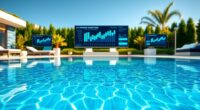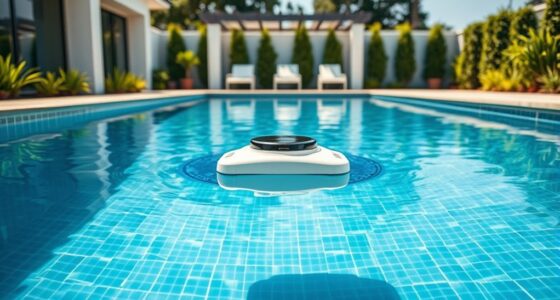Floating solar arrays can be a great way for you to generate renewable energy directly on your pool. By installing water surface-mounted panels, you can maximize space, reduce evaporation, and benefit from cooler temperatures that boost efficiency. However, you’ll need to contemplate maintenance challenges, such as debris cleaning and ensuring the structures are securely anchored against weather conditions. To discover more about optimizing your pool energy with floating solar, keep exploring the options available.
Key Takeaways
- Floating solar arrays on pools can generate renewable energy while saving space and reducing land use.
- Water surface reflections and cooler temperatures can enhance solar panel efficiency for pool systems.
- Proper waterproofing, heat dissipation, and corrosion-resistant materials are essential for reliable pool-mounted floating solar.
- Regular maintenance is needed to prevent debris buildup, algae growth, and structural wear due to water exposure.
- Advanced floating solar technology improves durability and ease of maintenance, making pool energy supply more sustainable.

Have you ever wondered how solar energy can be harnessed on water surfaces? Floating solar arrays make that possible by installing solar panels directly on water bodies, like pools, lakes, or reservoirs. These systems are designed to maximize sunlight capture while offering unique benefits over traditional ground-mounted solar panels. When you’re considering floating solar for your pool, one of the key factors to evaluate is solar panel efficiency. Since these panels are exposed to water and often subject to reflections, their efficiency can differ from land-based systems. The water surface can enhance sunlight absorption because of reflections, potentially increasing energy output. However, the efficiency can also be affected by factors like water temperature, which tends to be cooler and can improve panel performance, or by water vapor and humidity, which may cause condensation and reduce efficiency if not properly managed. To optimize solar panel efficiency, it’s important to choose high-quality, waterproof panels with good heat dissipation qualities, as excess heat can lower their performance. solar panel efficiency can also be influenced by the quality of materials used and proper installation techniques.
While floating solar arrays offer innovative ways to generate energy from water surfaces, they also come with maintenance challenges that you need to consider. Unlike land-based systems, these arrays are constantly exposed to water, which can lead to issues like corrosion, algae growth, and debris accumulation. Regular cleaning is necessary to prevent dirt, algae, and bird droppings from blocking sunlight, which can markedly reduce efficiency. Additionally, the water movement and weather conditions can create mechanical stress on the floating structures, making maintenance more complex. You might have to inspect anchors, pontoons, and connections frequently to ensure everything remains secure and functional. Environmental factors also play a role; storms or high winds can damage the arrays or displace them if not properly anchored. Maintenance challenges are compounded by the fact that some components are harder to access when installed on water, requiring specialized equipment or boats for repairs. This can increase costs and downtime compared to traditional solar installations.
Despite these challenges, floating solar arrays are gaining popularity because they help conserve land space and reduce water evaporation, which benefits pool or reservoir management. When you understand the balance between maximizing solar panel efficiency and managing maintenance challenges, you can better assess whether floating solar is right for your needs. Proper planning, high-quality equipment, and regular upkeep can ensure that your floating solar system performs at its best while minimizing downtime and repair costs. With advancements in technology and better materials, these systems are becoming more reliable and easier to maintain, making them a promising option for sustainable energy generation on water surfaces.
Frequently Asked Questions
What Is the Typical Lifespan of Floating Solar Arrays?
Floating solar arrays typically last 25 to 30 years. You can expect good solar panel durability, especially with proper maintenance, ensuring you get the most out of your investment. These arrays also provide environmental benefits by reducing water evaporation and cooling the water, which enhances efficiency. Over time, regular inspections help maintain ideal performance, making floating solar arrays a sustainable and long-lasting energy solution for your pool.
How Do Floating Solar Arrays Impact Pool Water Quality?
You might notice that floating solar arrays help stabilize water temperature fluctuations, which can prevent algae growth. By shading the pool, they reduce sunlight exposure, therefore maintaining clearer water and improving quality. This natural barrier minimizes chemical use and keeps your pool cleaner longer. As a result, these arrays support healthier water conditions while providing energy, making your swimming experience more enjoyable and eco-friendly.
Are Floating Solar Arrays Suitable for All Pool Sizes?
Floating solar arrays are suitable for most pool sizes, especially if you want to enhance energy efficiency. During pool installation, you can customize the system to match your pool’s dimensions, ensuring ideal coverage and energy generation. Larger pools benefit from more extensive arrays, but even smaller pools can use floating solar to reduce energy costs. Always consider your pool’s size and energy needs to determine the best setup for maximum efficiency.
What Maintenance Is Required for Floating Solar Systems?
You need to keep a regular cleaning schedule for your floating solar system to prevent dirt and debris from reducing efficiency. Check the panels for dirt, algae, or bird droppings weekly and clean them with a soft brush or cloth. Also, monitor battery upkeep, ensuring they stay charged and are stored properly if not in use. Regular inspections and maintenance help prolong system performance and maximize energy output.
How Cost-Effective Are Floating Solar Arrays Compared to Traditional Systems?
Floating solar arrays are generally more cost-effective than traditional systems when you consider the cost comparison over time. Although installation costs can be higher upfront due to setup on water surfaces, you save on land and infrastructure expenses. Plus, these systems often have lower maintenance costs and generate more energy per unit area, making them a smart investment for reducing long-term energy expenses.
Conclusion
Floating solar arrays are like mirrors catching sunlight on your pool’s surface, turning it into clean energy effortlessly. By installing these arrays, you not only reduce your carbon footprint but also keep your pool cooler and more comfortable. It’s a smart, eco-friendly choice that’s as invigorating as a cool breeze on a hot day. Embrace floating solar technology to make your pool smarter, greener, and more sustainable—just like a lighthouse guiding the way to a brighter future.









